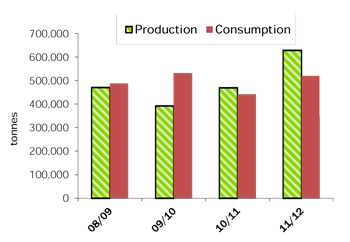After last week’s ITMA Flash I about Huntsman Textile Effects, the Rupp Report is looking at the
suppliers of spinning equipment in general and firstly at Switzerland-based Rieter AG with its
headquarters in Winterthur. The Rupp Report spoke to Edda Walraf, head of marketing, and Reto Thom,
senior vice president and head of sales, Spun Yarns Systems, about their impressions of ITMA 2011.
With the introduction of Rieter’s air-jet spinning technology, the company is the only manufacturer
worldwide that offers all four spinning technologies existing on the market: ring spinning, compact
spinning, rotor spinning and air-jet spinning.
Too Many ITMAs
In the roundup of questions, it was interesting to hear the feedback from the companies
about how they see the current concept of ITMA. Both Walraf and Thom confirmed that they still
don’t like it the way it is organized. Every two years, alternating between Europe and Asia, would
be good enough, due to the fact that there are many local shows in Asia that present machinery to a
broad audience.
Most visitors at ITMA 2011 came from India, South America – Brazil and Mexico in particular
– as well as Europe and the Middle East; but also, many important Asian customers came from outside
Mainland China.
Expectations Fulfilled
However, visitor frequency was very good, and the quality of the visitors was considered to
be extremely high. “Yes,” both said, “our expectations were entirely fulfilled.” Walraf mentioned
the fact that exhibitors with large booths, such as Rieter, were placed along the walls. “This,”
she added, “was rather strange to see. Our customers had to walk a long way to find us.”
Is the European market still attractive for Rieter? “Of course,” Thom said,” the European
market is still important for us – especially at the moment, if Turkey is considered to be a
European market. However, the Asian markets are obviously more important, with countries such as
India, China and Indonesia in the forefront.”
And how about problems? “Well,” Walraf mentioned, “the actual economical situation is not
very favorable for Swiss suppliers due to the fact of the very strong Swiss franc compared to the
U.S. dollar and the euro.”
New Products
Rieter presented quite a large array of new products, such as the new J 20 air-jet machine
with maximal productivity and minimal space requirement. Another mentioned item was the new version
of SPIDERweb, said to be the only data-monitoring system that records all production and quality
data for the complete Rieter system installations, and which serves as a basis for production and
quality increases. Special emphasis was placed on the new C 70 high-performance “2nd generation”
card, with increased performance and production quality compared to the preceding model; the new
VARIOline blow room line for gentle fiber preparation, even at high production speeds and with a
high level of raw material contamination; and last, but not least, the new RSB-D 45 draw frame with
sliver coiling and improved operation, and offering a further increase in quality.
Market Situation
And which product was the top runner with the most feedback among the Rieter exhibits?
“There is no doubt that the new air-jet spinning machine was the highlight,” Thom said. “Thanks to
our competence in mastering all four spinning technologies, we are in a unique position to offer
turnkey spinning plants from one source. This is highly appreciated by our global clientele.”
Rieter had a fantastic first quarter 2011, Walraf and Thom mentioned. The problems are the
currencies, which lead to distortions and losses. However, thanks to the ongoing stabilization of
the main markets, the current market situation in general is improving, and Rieter expects a much
better fourth quarter 2011.
Last week, the Rupp Report contacted Walraf to ask if there were any changes since the
interview in Barcelona. “No, the positive impressions from ITMA Europe are highly confirmed,” she
said. “The volatile currencies are still one of the main topics. On the other hand, China is still
booming. Currently, there is a head-to-head race going on between China and Turkey to occupy first
place in terms of order-placing on the market.”
The Future
Coming back to the interview in Barcelona, both Walraf and Thom are a bit skeptical for the
future. “We don’t believe in a new boom,” said Walraf, “but it seems that we are coming back to a
‘normal’ and well-balanced level.”
And how do they see development for their products over the next few years after ITMA 2011?
“We really believe that ITMA Europe is evolving in a direction of being the true high-performance
exhibition regarding technology and new products,” Thom said. “On the other hand, and this has
nothing to do with quality aspects, ITMA Asia will be more the place to show commodity products.”
However, there is no doubt that Rieter will take part in ITMA Asia, which takes place in only a few
months. On the other hand, the decision for Rieter to go to ITMA 2015 in Milan was mentioned to be
“supposable.”
November 22, 2011





